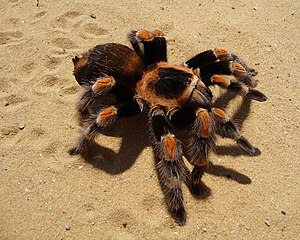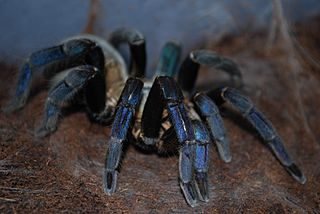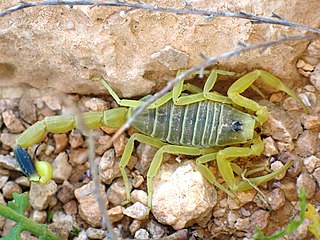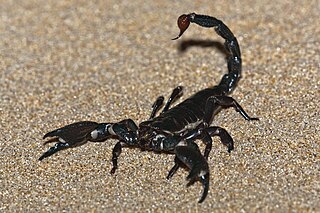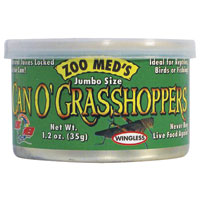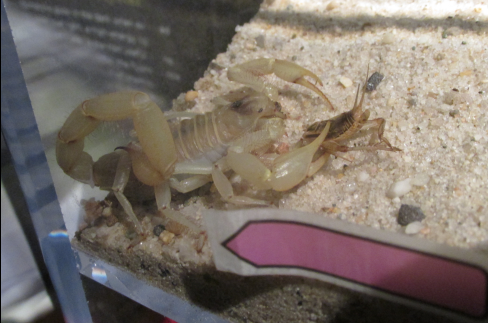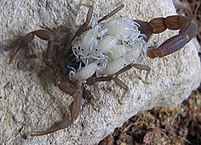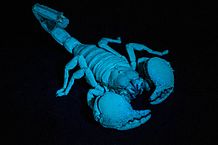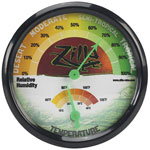
Uploaded to Wikipedia Commons by Sheri (Bellatrix on Flickr)
Over 30 years ago, a good friend and Bronx Zoo coworker amassed what was almost certainly the USA’s largest and most varied tarantula collection. He personally collected many of the spiders, and established several notable breeding firsts. Then as now, the massive Goliath Bird Eating Spider or Goliath Tarantula (Theraphosa blondi, then known as T. leblondi) topped the wish lists of zoos and advanced private keepers. I cared for my friend’s collection when he was studying Brown Tree Snakes in Guam. Although well-experienced in keeping large, aggressive spiders, birds, mammals and reptiles, caring for wild-caught Goliaths in the dark (I had promised not to disturb their day/night cycle) really put me to the test!
The huge females were ravenous, and far bolder at night than by day. They rushed at water being poured into bowls, and seemed to snatch dead pinkies before they hit the terrarium floor. I was hampered by the lack of a headlamp, working instead with a flashlight clamped between neck and shoulder. All went well until something jumped from the wall onto my arm, then to my chest. I froze, but was relieved to see that the “visitor” was the resident Tokay Gecko and not an irritated tarantula! Today we’ll look at the care of these fascinating but somewhat demanding spiders.
A Giant Among Giants
As invertebrate enthusiasts know, the Goliath Tarantula is the world’s largest spider. While the Giant Huntsman Spider (Heteropoda maxima) and one or two others may slightly top the Goliath’s near 12 inch leg span, none approach its bulk. One account lists a weight of 175 grams for a captive female…by comparison, the average house mouse (wild, not lab) tops out at 20-30 grams!
At present, the genus contains two other species, – T. apophysis, described from Venezuela in 1991, and T. sterni, described from Guyana in 2010. The Panama Red-Rumped Tarantula was included in Theraphosa for a time, but is now classified as Sericopelma rubronitens.
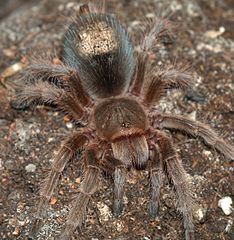
Uploaded to Wikipedia Commons by Sarefo
A Note Concerning Handling
While certain tarantula species may become relatively calm in captivity, they cannot be “tamed” and should never be trusted on bare skin – Ignore You Tube videos to the contrary, please! Goliath Tarantulas usually remain high strung, even when provided with ideal captive conditions. They are very quick to flick hairs and bite when a threat is perceived. I and several arachnologist friends have worked with tarantulas at home, in zoos, and in the field for 50+ years without being bitten…because we do not handle tarantulas!
If it becomes necessary to move a tarantula, do so by urging it into a plastic container with a long handled tongs. Wear goggles around New World species, as all can flick urticating hairs into the air when disturbed (please see photo of “bald patch” on a tarantula). A colleague of mine required cornea surgery to remove the hairs shed by a Mexican Red Knee Tarantula. Hairs remaining on hands, terrarium tops, and other surfaces are as dangerous as those recently shed by a spider.

Uploaded to Wikipedia Commons by HTO
All tarantulas are capable of delivering a painful bite. Human fatalities are unknown, but their venoms are relatively unstudied, and an allergic reaction is always possible. A doctor should be consulted immediately if a bite is suffered.
The Terrarium
Goliath Tarantulas are best kept in screen-covered aquariums. “High” style tanks are ideal, as they spend most of their lives in deep burrows, and will be stressed if not provided with such (some individuals adapt to surface caves, but burrows are preferable). Be sure to use extra cage clips on the cover, as tarantulas can climb glass and are incredibly strong. A 20 gallon aquarium is adequate, but I (and, I presume, the spiders!) much prefer a tank of 30-40 gallons capacity.
A wide variety of live plants may be used, although the spider may disturb these until a burrow site is chosen, Earth Stars (Cryptanthus) and other tough, low-light species are ideal; please post below for further information.

Uploaded to Wikipedia Commons by Pedro Gutiérrez.
Substrate
A mix of coconut husk, top soil, and peat moss works well with these rainforest natives. Add just enough water so that the substrate sticks together when squeezed…keeping it so will prevent burrow walls from caving-in. Sphagnum moss can be worked into the soil in order to improve its moisture-holding capacity. Some keepers have done well by using 4-5 inches of substrate, but I provide adults with 8-12 inches or more.
Wild tarantulas often excavate burrows (or take over those occupied by their last meal!) beneath fallen logs, tree stumps and other cover. Several of the burrowing species I’ve cared for have used turtle huts and similar structures as starting points for their burrows. These and other caves should also be available for use until the spider constructs its own retreat.
Some keepers bury cork bark rolls with one edge facing the terrarium glass, and construct a tunnel that leads to the surface. In this way, the spider can sometimes be observed within its burrow. Please post below for further information.
Light and Heat
Red or black reptile night-viewing bulbs will not disturb your spiders and will assist you in observing their nocturnal activities.
Goliath Tarantulas are native to northern South America’s hot, humid rainforests and riverside thickets. They should be maintained at a temperature gradient of 80-86 F. Night-viewing bulbs, sub-tank heat mats and/or ceramic heater emitters can be used to warm the terrarium. All heat sources will dry out the terrarium, so it is important to monitor humidity.
 Humidity
Humidity
Proper humidity levels are critical to good health, normal activity, and successful shedding (becoming stuck in a molt is a leading cause of death among captive Goliath Tarantulas). This tropical forest native requires humidity levels in the range of 75-85%. A hygrometer (humidity monitor) is an essential piece of equipment for the serious tarantula keeper. In dry environments, a small mister should be considered.
Just before and during the molt (please post below for further details re molting) humidity can be increased by partially covering the terrarium’s lid with plastic. As air flow is critical to good health, this option should only be used for limited periods.

Uploaded to Wikipedia Commons by Snakecollector
Food and Water
While some folks have had success with cricket-based diets, variety is preferable, especially if breeding is contemplated. I’ve done well by basing the Goliath diets on roaches and earthworms, with crickets being used less often. I also offer katydids, locusts, field crickets, moths and other wild-caught insects during the summer months, and notice that these often induce a very vigorous feeding response (please post below for more information on using wild-caught insects).
Although wild Goliath Tarantulas frequently ambush frogs, lizards and, perhaps, small rodents, a vertebrate-based diet is not recommended. Pre-killed pink mice can, however, be supplied every 2-4 weeks; some keepers believe this to be especially beneficial to breeding females. These voracious predators will readily accept dead prey moved about with a forceps or, in some cases, simply left in the terrarium; live mice should not be offered.
Incidentally, the “bird-eating” reference arose in 1705, when Swiss naturalist Maria Sibylla Merian included, in a book on the insects of Suriname, a painting of a Pink-Toed Tarantula consuming a hummingbird. The name she coined, “Bird-eating Spider”, remains in common usage today. While I’ve no doubt that a Goliath Tarantula would happily make a meal of any bird nestlings it might happen upon, this is likely a rare occurrence in the wild.
Canned grasshoppers and other invertebrates moved about with a long-handled forceps (remember, tarantulas have poor vision and may strike well above the food item – do not risk a bite!) can be used to provide occasional dietary variety.
Although spiders are able to obtain water from their prey, a shallow water bowl seems critical to success in keeping Goliath Tarantulas. The enclosure should also be misted daily.
Further Reading
Tarantula Care and Natural History
Beyond Webs: Swimming, Spitting and other Spider Hunting Strategies
 That Reptile Blog – Reptile, Amphibian and Exotic Pet Care and Information
That Reptile Blog – Reptile, Amphibian and Exotic Pet Care and Information

